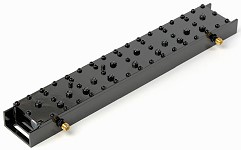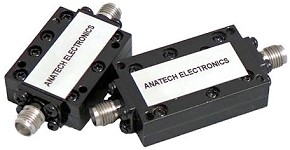|

Sam Benzacar of
Anatech Electronics, an RF and microwave filter company, has published his February
2024 newsletter that, along with timely news items, features his short op-ed entitled
"Satellites Join Terrestrial 5G," in which he summarizes the state of the art for
satellite direct to cell[phone] (DTC) communications. The massive satellite constellations
that are beginning to clutter the night sky (and the day sky, but that doesn't matter
much to visible light astronomers) have orbits low enough to make signal travel
time latency negligible compared to the quarter second or so for geostationary satellites.
LEO satellites be at around 330 miles above sea level and geostationary be
at around 22,236 miles, so LEO latency is roughly 2% that of geosynchronous.
Of course the latency also depends on how far from the phone's zenith the satellite
lies. While data rates for the mini Earth stations with a parabolic dish are in
the neighborhood of 10-20 Mbps, for a cellphone the rates are good enough for
text messaging (SMS), but that's about it. It's considered by many to be an emergency
mode at this point in DTC communications.
A Word from Sam Benzacar - Satellites Join Terrestrial 5G
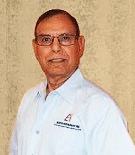 By Sam Benzacar By Sam Benzacar
While cellular networks have since their inception been terrestrial, Low Earth
Orbit satellites (LEOs) are rapidly emerging as complementary. This integration
has the potential to be an equalizer, ushering in a new era of communication that
doesn't leave anyone behind.
Traditionally, satellite communication has existed as a separate entity, offering
limited data capabilities and higher latency compared to terrestrial networks. However,
5G allows earth-to-satellite communication to seamlessly integrate with the 5G ecosystem
using its advanced technologies and protocols. These Non-Terrestrial Networks (NTNs)
allow seamless connectivity even when users travel internationally between regions
with different terrestrial network specifications.
Unlike traditional geostationary satellites orbiting at high altitudes, LEO satellites
operate much closer to Earth, significantly reducing latency crucial for enabling
real-time applications like video conferencing and autonomous vehicles, even in
remote locations. NTNs also offer inherent advantages like resilience and security.
Unlike terrestrial networks susceptible to natural disasters or infrastructure damage,
satellite networks can provide backup connectivity to users, potentially bypassing
terrestrial infrastructure.
In addition, rural communities can avail themselves of e-commerce, distance learning,
telehealth services, and the many other services that most of us take for granted.
It will also significantly benefit first responders fighting natural disasters such
as wildfires, floods, earthquakes, coastal storms and hurricanes. The far-reaching
coverage of satellite networks also enables large-scale Internet of Things (IoT)
deployments. This helps applications like global asset tracking, remote monitoring
of infrastructure and equipment, and data collection in agriculture and environmental
sectors.
Satellites excel at broadcasting information to many users within their footprint.
This is important for services like emergency alerts, news updates, or live event
transmissions to widely dispersed audiences. Satellite networks provide a crucial
backup layer in critical sectors like energy grids, financial institutions, or transportation
infrastructure. Any disruption to terrestrial systems can have cascading effects,
making satellite communication a safety net for continued operations.
Beginning with the iPhone 14 and now the iPhone 15 series, Apple already offers
satellite connectivity for emergency SOS via a partnership with Globalstar. Currently,
this feature primarily focuses on sending short emergency text messages and location
data when out of cellular range, but it will likely expand to include voice and
data within a year or two. In addition, T-Mobile and SpaceX have struck a deal to
directly connect new smartphones to Starlink satellites, mainly targeting areas
without traditional cell coverage.
Integrating non-terrestrial satellite communications into the 5G ecosystem is
still in its initial stages, but the potential benefits are already apparent. As
the technology evolves, we can expect even broader and more innovative use cases,
further shrinking the digital divide and transforming how we connect with the world.
 Raytheon Completes Directed-Energy
Weapon Test Raytheon Completes Directed-Energy
Weapon Test
Raytheon’s Counter-Electronic High-Power Microwave Extended-Range Air Base Defense
(CHIMERA) high-power directed energy system successfully engaged multiple static
targets, demonstrating its ability to acquire and track aerial targets throughout
their flight paths. The tests were performed for the Air Force Research Laboratory
and conducted at the White Sands Missile Range in New Mexico. The CHIMERA program
is part of the Directed Energy Front-line Electromagnetic Neutralization and Defeat
(DEFEND) program that plans for prototypes by 2026. The company is also developing
a transportable directed-energy system for the Army, for which it has been awarded
a three-year, $31.3 million contract from the Naval Surface Warfare Center.
 FCC Tightens Rules for
Emergency Notifications FCC Tightens Rules for
Emergency Notifications
The Federal Communications Commission updated rules to improve communications
network reliability, resiliency, and transparency during disasters and outages.
Certain types of communications providers must report network outages to the FCC’s
Network Outage Reporting System (NORS). During disasters, the FCC can activate DIRS
to gain greater situational awareness and keep public safety officials and the public
informed about service outages and service restoration. However, as industry participation
in DIRS is voluntary, the result has been gaps in information that impair emergency
response times.
 Korea Ramps up 6G Research
Spending Korea Ramps up 6G Research
Spending
The Ministry of Science and ICT of South Korea will invest more than $130 billion
to advance capabilities that will allow the country to implement 6G. In August 2023,
South Korea announced it had finished preliminary studies on 6G and will begin developing
commercial 6G technology later this year to secure 6G patents throughout the program.
The country intends to develop low-power design and signal processing technology
for core components of base stations to improve energy efficiency by advancing core
network management technology and increasing the use of software.
 Microsoft to Begin Terahertz
Testing Microsoft to Begin Terahertz
Testing
The FCC has approved Microsoft’s request to research communications in the sub-terahertz
region in the U.S. The company’s experiments will be performed at its facilities
in Redmond, WA, and will focus on frequencies between 246 and 275 GHz. While there
are existing sub-terahertz testbeds at academic labs, this testbed will evaluate
the use of multi-hop RF links to mitigate the obstacles present in data centers
and focus on topologies suitable for a typical structure and layout of large-scale
data centers.
 Japan Puts First Ham Station
on the Moon Japan Puts First Ham Station
on the Moon
When Japan's Smart Lander for Investigating Moon (SLIM) touched down on the Moon
it released two tiny robots, LEV-1 and LEV-2, the former holding the title of the
Moon's first amateur radio station, sporting its own license, JS1YMG. This little
rover receives data from LEV-2, then sends it Earthward using Morse code via a 1-W
UHF amplifier and gain antenna. The JAXA Ham Radio Club orchestrated the feat, which
secured the license and has kept the Morse code flowing since January 19.
Anatech Electronics Introduces a New Line of Suspended Stripline and
Waveguide Type RF Filters
Check out Our Filter Products
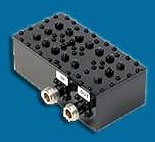
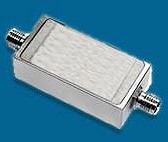

Cavity Band Pass Filters
LC Band Pass Filters Cavity Bandstop/Notch Filter
About Anatech Electronics
Anatech Electronics, Inc. (AEI) specializes in the design and manufacture of
standard and custom RF and microwave filters and other passive components and subsystems
employed in commercial, industrial, and aerospace and applications. Products are
available from an operating frequency range of 10 kHz to 30 GHz and include cavity,
ceramic, crystal, LC, and surface acoustic wave (SAW), as well as power combiners/dividers,
duplexers and diplexers, directional couplers, terminations, attenuators, circulators,
EMI filters, and lightning arrestors. The company's custom products and capabilities
are available at www.anatechelectronics.com.
Contact:
Anatech Electronics, Inc.
70 Outwater Lane
Garfield, NJ 07026
(973)
772-4242
sales@anatechelectronics.com
Posted February 31, 2024
|










 By Sam Benzacar
By Sam Benzacar Raytheon Completes Directed-Energy
Weapon Test
Raytheon Completes Directed-Energy
Weapon Test  FCC Tightens Rules for
Emergency Notifications
FCC Tightens Rules for
Emergency Notifications  Korea Ramps up 6G Research
Spending
Korea Ramps up 6G Research
Spending  Microsoft to Begin Terahertz
Testing
Microsoft to Begin Terahertz
Testing  Japan Puts First Ham Station
on the Moon
Japan Puts First Ham Station
on the Moon 